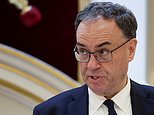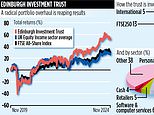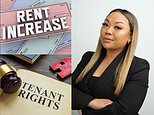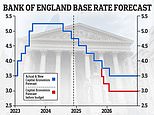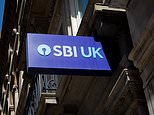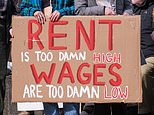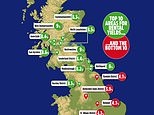The best buy-to-let mortgages for landlords: Should they fix or risk a tracker?
- We ask experts if two-year fixes, five year fixes or tracker mortgages are best
- We reveal the best buy-to-let deals on offer and consider what next for rates
- We also look at the best deals for limited company landlords
Buy-to-let landlords are being hit by higher interest rates, higher costs and a less friendly tax regime.
Many have seen their mortgage costs spiral meaning they by and large will be hoping for falling interest rates just as much as homeowners and first-time buyers.
There are roughly two million buy-to-let properties that have a mortgage attached, according to the trade association for the banking and financial services sector, UK Finance.
The average two-year fixed rate buy-to-let mortgage is currently 5.34 per cent, according to Moneyfacts. The average five-year fix is 5.45 per cent.
The lowest five-year fixed rate deal the market is currently 3.85 per cent while the lowest two-year fix is 3.34 per cent, albeit both deals come with very hefty fees.
We look at what landlords need to consider when taking a new mortgage, and list some of the best deals available. Both for those who own in their own name and for those who own via a limited company.
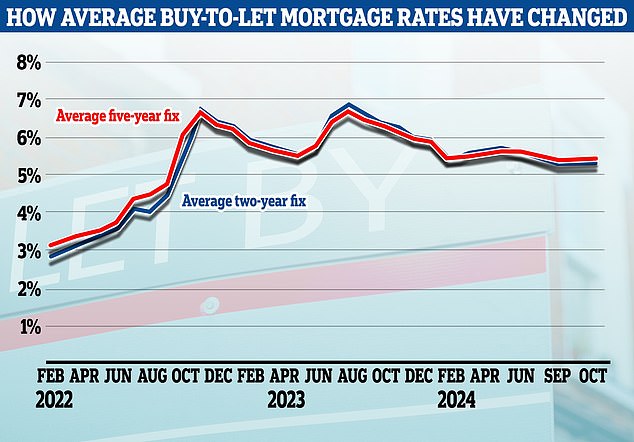
How cheap are buy-to-let mortgage rates?
Many landlords who own with a mortgage will be seeing their profits decimated by higher mortgage rates, having been lulled into a false sense of security by the ultra-cheap finance available in recent years.
Mortgaged buy-to-let investors often use interest-only mortgages to ensure higher cashflow. But when paying interest-only, if the mortgage rate doubles or triples, so do the monthly payments.
Both the average two-year fixed rate buy-to-let mortgage and five-year fixed rate are currently hovering around 5.4 per cent, according to Moneyfacts.
It means a typical landlord requiring a £200,000 interest-only mortgage on a two-year or five-year fix will need to pay £901 a month in mortgage costs if buying or remortgaging at the moment, excluding fees.
Add that to the cost of periods where the property is empty, repairs, maintenance, letting agent fees, compliance checks, insurance and service charges and it shows how reliant many landlords will be on rents rising in order to turn a profit.
What about limited company mortgage rates?
A record number of landlords have set up limited companies to purchase buy-to-let properties this year, in a bid to reduce tax on their investments.
Between January and September this year, 46,449 buy-to-let companies were set up, a rise of 23 per cent on the same period last year.
That is according to analysis of Companies House data by the property firm Hamptons.
Holding property in a limited company, also known as 'incorporating', is an alternative to holding it in their own personal name, and the tax structure is different.

The new normal: 46,449 companies were set up between January and September 2024
For those who own in a limited company, average rates are typically slightly higher with bigger product fees on top.
The average two-year fixed rate limited company mortgage is 5.52 per cent while the average five-year fixed rate limited company mortgage is 5.67 per cent, according to Moneyfacts.
On a £200,000 mortgage the average company landlord could therefore expect to pay £920 a month over two years or £945 a month over five years.
The downside is that these will likely be accompanied by higher fees. The upside is that limited company landlords can fully deduct their mortgage interest costs from their tax bill.
Howard Levy, director of buy-to-let lending at mortgage broker SPF Private Clients, says: 'Many landlords who own in their own name are incorporating their portfolios, and others are selling up given the profits they were making are now losses due to tax changes.

Expert: Howard Levy, director of buy-to-let lending at mortgage broker SPF Private Clients
'Many landlords fixed their mortgages three, four or five years ago, so there will be a tranche of funds coming up for review in the next 12 to 24 months and it will be interesting to see what happens.
'The main determinant will be where interest rates are at that time, or more specifically about four to six months prior to those rates expiring.'
In July, Metro Bank entered the limited company buy-to-let market.
Traditionally, only specialist buy-to-let lenders operated in this space, but in recent years, smaller building societies such as Leeds, Leek, Family, Mansfield, and Nottingham have also started offering limited company products.
Chris Sykes, technical director at broker Private Finance says: 'Now, Metro Bank has entered this market, and discussions with various lenders suggest that many more will be soon, including high street lenders, so we feel this market will feel more and more vanilla as time goes on.
'Metro Bank and other new entrants will be targeting smaller landlords purchasing through a company, rather than large portfolio landlords who still need to use specialist lenders and pay higher rates.
'Once a landlord owns around 10 buy-to-let properties, they usually need to work with more complex lenders.
'Specialist assets like Houses in Multiple Occupation (HMOs)and Multi-Unit Freehold Blocks (MUFBs) also require specialist lenders.
'Holiday lets are now fairly widely accepted by building societies but given the recent tax changes to how holiday lets are treated, we expect to see more lenders accepting ltd company holiday lets too.'

Tax perks: As the gap between personal and corporate tax rates may widen further in the Budget, there has been a surge of landlords incorporating
In terms of rates, Chris Sykes thinks that there rates are likely to fall a little further across limited company products.
'In general residential mortgage rates seem to have hit the floor and there isn’t any margin for them to lower,' added Sykes.
'On the ltd company buy to let mortgage side of things, I think there is a little room for movement, but they do demand a premium for their complexity and additional risks compared to residential deals though.'
What does it mean for landlords?
Many of the landlords who are now remortgaging had become accustomed to rock bottom rates.
For example, someone who purchased five years ago will have enjoyed an average five-year fixed rate of around 3.5 per cent, according to Moneyfacts.
It means on a £200,000 mortgage they would have factored in monthly mortgage costs of around £584 - not the £875 they are likely to face when remortgaging today.
That said, mortgage rates are lower than they were during the summer last year meaning the situation is not as dire as it was.
The average two-year fixed rate for buy-to-let reached a high of 6.97 per cent in July, while the average five-year fixes hit 6.82 per cent.
On a £200,000 interest only five-year fixed rate mortgage, that's the difference between having to pay £1,137 a month when fixing in July compared to £875 a month at the moment.
Some landlords will do much better than the market average, by using a whole-of-market mortgage broker to find them a cheaper rate. This will depend to some extent on how much equity they have in the property.

Financial shock: Many landlords who own with a mortgage will be seeing their profits cut down by higher mortgage rates
A word of warning here: many of the lowest buy-to-let mortgage rates come with staggeringly high fees. These can be as high as 10 per cent of the total mortgage amount in some cases. On a £200,000 mortgage that would equate to £20,000.
This means it's essential to look at the overall cost of the mortgage and factor in both the fees and the interest rate.
To secure the cheapest deal, landlords will also typically need to be buying with at least a 40 per ent deposit or be remortgaging with at least 40 per cent equity in the property.
Chris Sykes of broker Private Finance says the situation is a lot better for landlords now than it was last year.
'Last year, I had landlords who didn't buy a single property when usually they buy four or five each year.
'Some of those landlords have already bought four or five this year, so are making up for lost time. It's much more of a buoyant market at the moment.
'There are some landlords who are exiting the market and some are a bit worried by Labour being in power, but others are happy to hold out for the long term and are even in support of what Labour are doing.
'Some of those that have not been in game so long and may have geared up their portfolio with a lot of debt may be struggling. But most seem to be finding solutions to keep going.'
How to assess where mortgage rates are heading?
Nobody wants to lock into a 5.25 per cent five-year fix in 2024 only to find they could have remortgaged onto a 3 per cent rate in 2026 if they had opted for a two-year fix instead.
At present, markets are pricing in one or two further rate cuts in 2024. If forecasts are correct, this could mean base rate will fall to 4.75 or 4.5 per cent by the end of 2024.
Looking further ahead, financial markets are forecasting base rate will fall to around 4 per cent by the end of next year before eventually settling at around 3.5 per cent.
But predictions vary widely.
Santander is predicting Interest rates will fall to 3.75 per cent by the end of next year.
Looking further ahead, economists at the bank also believe UK interest rates will remain between 3 per cent and 4 per cent for the foreseeable future.
Goldman Sachs has given the most bullish of forecasts suggesting base rate will come down to as low as 2.75 per cent by the end of 2025.
Lenders tend to price their fixed-rate mortgages based on future market expectations for the Bank of England's base rate.
Market expectations are reflected in swap rates - financial market rates which anticipate where interest rates will be in two and five years' time, when fixed mortgages lent today will expire.
As of 18 November, five-year swaps were at 3.99 per cent and two-year swaps are at 4.22 per cent.
From a historic perspective, the lowest fixed rate mortgages very rarely go below the equivalent swaps.

Expert: Chris Sykes, associate director of mortgage broker Private Finance
This means fixed mortgage rates will only fall significantly if future interest rate expectations fall further over the coming months and years.
You can check best buy tables and the best mortgage rates for your circumstances with our mortgage finder powered by London & Country - and figure out what you'll actually be paying by using our new and improved mortgage calculator.
'We are not expecting to see rates go much lower from where they are now,' says mortgage broker,' Chris Sykes.
'Fixed rates are already pricing in where lenders are expecting rates to go. We may see slight reductions as times goes on but we are not expecting anything dramatic.
'Base rate is likely to come down but slowly, with possibly two more reductions this year,' adds Howard Levy.
'If this happens, two- and five-year Swap rates should also reduce. However, it is worth mentioning that even when base rate comes down, lenders have often already priced this occurrence into their mortgage rates so it doesn't always follow that lender rates will fall by the same amount.
'The change lenders make to their rates can therefore be more or less than the reduction that the Bank of England makes.'
Should you fix or take a tracker?
The case in favour of fixing for five years
Five-year fixes currently offer some of the cheapest deals, and having certainty over monthly payments for the next five years may also appeal to some borrowers, given how much interest rates have shot up over the past 24 months.
And fixing for five years, rather than two years, can sometimes enable landlords to borrow more.
This is because lenders tend to impose more generous affordability tests.
Chris Sykes says: 'I'd say the vast majority are forced onto a five year fixes in order to achieve the level of borrowing they need. Two year deals are basically not even an option for most landlords.'
Howard Levy adds: 'The bigger landlords seem to be sticking with five-year fixes, preferring to lock in for the longer term.
'They do get the equivalent of pound cost averaging though, as rate expiries are coming up for these clients all the time, so if rates drop they book a five-year fix at that time for the next few properties for example.
'For those who own buy-to-lets in their personal name, typically, a five-year fix will be stressed at a lower rate than a two-year fix.
'Given the existing borrowing, higher rates and higher interest cover ratios, it may not be possible to raise the level of funds required without fixing for five-years in some cases.'
'Paying higher product fees, achieving higher rental incomes, or not being classed as a higher-rate taxpayer are also ways to boost maximum borrowing levels.'
The case in favour of fixing for two years
Many of those opting for a two-year fix will be doing so because they think interest rates will fall over the next couple of years.
They are banking on the expectation that once inflation subsides, the base rate - and then mortgage rates - will come down, allowing them to fix at a cheaper rate.
Nicholas Mendes of mortgage broker John Charcol says: 'Predicting the trajectory of mortgage rates over the coming years is still risky business and while it is important to understand the market and make a balanced view on future rate movement it should not influence your decision if your someone who requires a longer period of stability. Getting the right advice is key.
'If inflation continues to pose a challenge, we should expect bank rate to be higher for longer, which would in turn result in a period of higher mortgage rates.
'But, given the current movement and overall landscape, I do expect to see a gradual reduction in mortgage rates over time.'
Howard Levy of SPF Private Clients argues that many landlords are avoiding the stress testing required for shorter fixes by sticking with their current lender when they refinance.
He adds: 'Two-year fixed rates don't usually fit stress tests on a remortgage, unless the loan-to-value is relatively low, but they would be available for a product transfer.
'We are seeing many clients opt for a two-year fix for a product transfer with the view that in two years' time rates will be lower so they can remortgage onto a more palatable rate.'
The case in favour of a tracker mortgage
Those that are confident of rates falling faster and further than expected may even be trying their luck with a tracker mortgage.
Trackers follow the Bank of England's base rate, plus or minus a set percentage.
For example, someone could be paying base rate plus 0.75 per cent on top with a tracker. With the base rate at 5 per cent, they'd pay 5.75 per cent at present.
But if the base rate was cut to 4.5 per cent, for example, their rate would fall to 5.25 per cent.
The main benefit of tracker deals is that they typically don't come with early repayment charges.
This means if mortgage rates fell over the coming year, someone with a tracker deal could switch to a cheaper fixed deal as and when they liked.
On the flip side, if the base rate stays the same or even rises this year, it could end up becoming an expensive gamble.
Gamble: At present, borrowers opting for a tracker deal will likely pay more than if they fix. The hope is that interest rates will fall.
It's also worth pointing out that at present, tracker rates tend to be more expensive than fixed rates.
Howard Levy adds: 'The margin on tracker rates seems to have remained relatively high compared to the pricing of five-year fixes so they are proving less popular.
'With it looking as though base rate will come down gradually, many are opting for the certainty of a five year fix and a higher loan amount rather than the tracker with its possibility of future reductions and a lower loan amount.'
What are the best buy-to-let rates?
Below, we highlight some of the best deals available to buy-to-let landlords.
Buy-to-let mortgage rates often come with product fees that can be as high as 10 per cent of the loan. The below are the deals with the cheapest overall annual costs when both the initial rate, fees (for arrangement and valuation etc), and cashback are taken into account.
This is based on the property value being £200,000. The mortgages sourced are available for remortgage deals. For those purchasing, rates may be slightly different.
Please note, these rates were the best deals sourced as of 24 October 2024.
Cheapest deals for those owning in their personal name
40% deposit mortgages
Five-year fixed rate mortgages
BM Solutions has a five-year fixed rate at 4.29 per cent with 3 per cent fees at 65 per cent loan to value.
Leeds Building Society has a five-year fixed rate at 4.49 per cent with £0 fee at 60 per cent loan to value.
Two-year fixed rate mortgages
Santander has a two-year fixed product at 4.8 per cent with £49 fees at 60 per cent loan to value.
Leeds Building Society has a two-year fixed rate at 4.95 per cent with a 49 per cent fee at 60 per cent loan to value.
25% deposit mortgages
Five-year fixed rate mortgages
BM Solutions has a five-year fixed rate at 3.95 per cent with a 3 per cent at 75 per cent loan to value.
Leek Building Society has a five-year fixed rate at 4.42 per cent with 1,394 fee at 75 per cent loan to value.
Two-year fixed rate mortgages
Santander has a two-year fixed rate at 5.06 per cent with £49 fees at 75 per cent loan to value.
HSBC has a two-year fixed rate at 5.09 per cent with £0 fees at 75 per cent loan to value.
Best two-year tracker without early repayment charges
40% deposit
BM Solutions has a two-year tracker at 5.18 per cent with £1,499 fees at 65 per cent loan to value. This is base rate (4.75 per cent) plus 0.43 per cent.
25% deposit
BM Solutions has a two-year tracker rate at 5.28 per cent with £1,499 fees at 75 per cent loan to value. This is base rate plus 0.53 per cent.
Cheapest limited company remortgage options
Again, this is based on a property value of £200,000 and is the cheapest remortgage deals overall based on rates and fees.
40% deposit mortgages
Five-year fixed rate mortgages
State Bank of India has a five-year fixed rate at 4.94 per cent with a 2 per cent fee at 60 per cent loan to value. This is for green energy efficient homes.
Two-year fixed rate mortgages
Monmouthshire Building Society a has a two-year fixed product at 4.5 per cent with 3 per cent product fee at 60 per cent loan to value. The deal comes with a £150 application fee and valuation fee.
25% deposit mortgages
Five-year fixed rate mortgages
State Bank of India has a five-year fixed rate for green energy efficient homes at 4.99 per cent with a 2 per cent fee at 75 per cent loan to value.
Two-year fixed rate mortgages
Monmouthshire Building Society has a two-year fixed rate at 4.5 per cent with a 3 per cent fee at 75 per cent loan to value. The deal comes with a £150 application fee and valuation fee.






